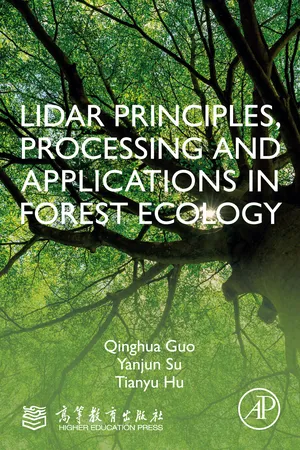
eBook - ePub
LiDAR Principles, Processing and Applications in Forest Ecology
- 510 pages
- English
- ePUB (mobile friendly)
- Available on iOS & Android
eBook - ePub
LiDAR Principles, Processing and Applications in Forest Ecology
About this book
LiDAR Principles, Processing and Applications in Forest Ecology introduces the principles of LiDAR technology and explains how to collect and process LiDAR data from different platforms based on real-world experience. The book provides state-of the-art algorithms on how to extract forest parameters from LiDAR and explains how to use them in forest ecology. It gives an interdisciplinary view, from the perspective of remote sensing and forest ecology. Because LiDAR is still rapidly developing, researchers must use programming languages to understand and process LiDAR data instead of established software. In response, this book provides Python code examples and sample data. Sections give a brief history and introduce the principles of LiDAR, as well as three commonly seen LiDAR platforms. The book lays out step-by-step coverage of LiDAR data processing and forest structure parameter extraction, complete with Python examples. Given the increasing usefulness of LiDAR in forest ecology, this volume represents an important resource for researchers, students and forest managers to better understand LiDAR technology and its use in forest ecology across the world. The title contains over 15 years of research, as well as contributions from scientists across the world.
- Presents LiDAR applications for forest ecology based in real-world experience
- Lays out the principles of LiDAR technology in forest ecology in a systematic and clear way
- Provides readers with state-of the-art algorithms on how to extract forest parameters from LiDAR
- Offers Python code examples and sample data to assist researchers in understanding and processing LiDAR data
- Contains over 15 years of research on LiDAR in forest ecology and contributions from scientists working in this field across the world
Frequently asked questions
Yes, you can cancel anytime from the Subscription tab in your account settings on the Perlego website. Your subscription will stay active until the end of your current billing period. Learn how to cancel your subscription.
At the moment all of our mobile-responsive ePub books are available to download via the app. Most of our PDFs are also available to download and we're working on making the final remaining ones downloadable now. Learn more here.
Perlego offers two plans: Essential and Complete
- Essential is ideal for learners and professionals who enjoy exploring a wide range of subjects. Access the Essential Library with 800,000+ trusted titles and best-sellers across business, personal growth, and the humanities. Includes unlimited reading time and Standard Read Aloud voice.
- Complete: Perfect for advanced learners and researchers needing full, unrestricted access. Unlock 1.4M+ books across hundreds of subjects, including academic and specialized titles. The Complete Plan also includes advanced features like Premium Read Aloud and Research Assistant.
We are an online textbook subscription service, where you can get access to an entire online library for less than the price of a single book per month. With over 1 million books across 1000+ topics, we’ve got you covered! Learn more here.
Look out for the read-aloud symbol on your next book to see if you can listen to it. The read-aloud tool reads text aloud for you, highlighting the text as it is being read. You can pause it, speed it up and slow it down. Learn more here.
Yes! You can use the Perlego app on both iOS or Android devices to read anytime, anywhere — even offline. Perfect for commutes or when you’re on the go.
Please note we cannot support devices running on iOS 13 and Android 7 or earlier. Learn more about using the app.
Please note we cannot support devices running on iOS 13 and Android 7 or earlier. Learn more about using the app.
Yes, you can access LiDAR Principles, Processing and Applications in Forest Ecology by Qinghua Guo,Yanjun Su,Tianyu Hu in PDF and/or ePUB format, as well as other popular books in Technology & Engineering & Agriculture. We have over one million books available in our catalogue for you to explore.
Information
Table of contents
- LiDAR Principles, Processing and Applications in Forest Ecology
- Chapter 1 The Origin and Development of LiDAR Techniques
- Chapter 2 Working Principles of LiDAR
- Chapter 3 LiDAR Field Workflow and Systematic Error Sources
- Chapter 4 LiDAR Data Formats
- Chapter 5 Data Preprocessing and Feature Extraction
- Chapter 6 LiDAR Data Filtering and Digital Elevation Model Generation
- Chapter 7 Forest Structural Attribute Extraction
- Chapter 8 Estimation of Forest Functional Attributes
- Chapter 9 Forest Structural and Functional Attribute Upscaling Using Spaceborne LiDAR Data
- Chapter 10 LiDAR-Based Three-Dimensional Radiative Transfer Models and Applications
- Chapter 11 Visualization and Reconstruction of Forest Ecosystems
- Chapter 12 Forest Dynamics Monitoring
- Chapter 13 Applications of LiDAR in Biodiversity Conservation, Ecohydrology, and Ecological Process Modeling of Forest Ecosystems
- Chapter 14 LiDAR Applications in Other Ecosystems
- Chapter 15 Challenges and Opportunities for LiDAR
- Index